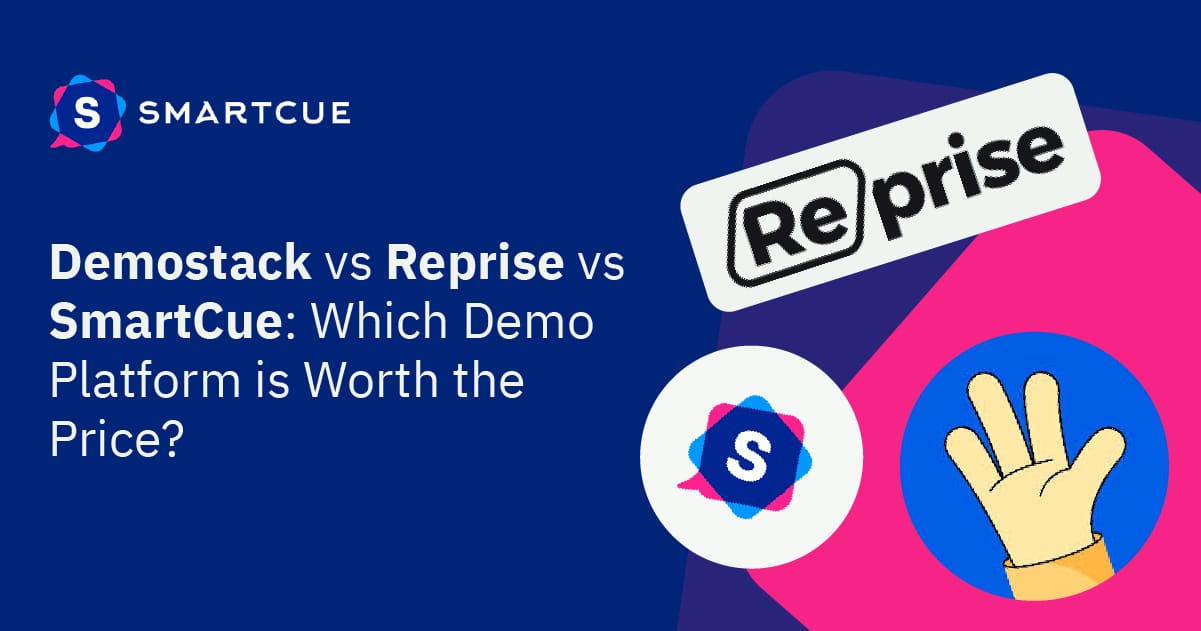
Key Highlights
Demostack, Reprise, and SmartCue are leading demo automation platforms designed to help SaaS teams create interactive product experiences without relying on engineers.
SmartCue brings a balance of simplicity, affordability, and intelligence, offering AI-powered demo creation, engagement tracking, and scalable sharing options tailored for startups, SMBs, and fast-growing teams.
Demostack focuses on speed and simplicity with its no-code demo cloning approach, making it easy for sales teams to replicate product interfaces and deliver consistent demos across teams.
Reprise offers greater customization and flexibility, allowing users to create live, click-through, and leave-behind demos that mirror the real product experience for technical buyers and enterprise clients.
While Demostack and Reprise cater primarily to enterprise-scale use cases, SmartCue stands out with its faster setup, user-friendly interface, and transparent pricing that make it accessible to teams of any size.
Choosing the right platform depends on what matters most to your organization, whether it’s deep customization, reliable demo performance, or the ability to scale quickly without breaking your budget for all stakeholders.
Every SaaS team has faced that moment, the demo that was supposed to seal the deal ends up stalling because of technical hiccups, lagging environments, or a setup process that takes longer than the actual presentation. You’ve got a great product, but showing it off seamlessly shouldn’t feel like a chore. The truth is, many sales and marketing teams waste hours trying to craft that perfect demo instead of focusing on what really matters: connecting with their audience and closing deals.
That’s where demo automation platforms come in. Tools like Demostack, Reprise, and SmartCue promise to make the demo process effortless, giving teams the power to create, personalize, and share product experiences that actually convert. But with each offering different features, pricing models, and learning curves, the choice isn’t always clear.
So, which one truly helps you showcase your product’s value, without the technical roadblocks or hefty enterprise price tags? Let’s take a closer look at how Demostack, Reprise, and SmartCue stack up when it comes to creating demos.
At a Glance: Demostack vs Reprise vs SmartCue
Feature / Category | Demostack | Reprise | SmartCue |
|---|---|---|---|
Overview | No-code demo experience platform that clones your product’s front end for stable, sandboxed demos | Enterprise demo creation platform for live, click-through, and leave-behind demos | No-code, AI-powered demo builder for interactive, trackable product showcases |
Best For | Mid-market to large enterprises needing consistent, reliable demos | Enterprise teams managing complex, customizable demos | Startups, SMBs, and enterprise teams wanting fast, affordable, scalable demos |
Demo Type | Cloned UI replicas (sandboxed) | Live interactive demos, click-through tours, and reusable leave-behinds | Screen capture–based demos with tooltips, chapters, and lead capture |
Ease of Use | Simple, no-code setup for linear demos | Steeper learning curve; best for experienced teams | Very intuitive, plug-and-play setup |
Customization Level | Moderate – text and UI edits only | High – supports HTML editing and multi-step flows | Moderate to high – easy personalization with AI support |
Analytics & Insights | Basic engagement tracking | Detailed analytics on clicks and completion | Deep engagement analytics with interaction tracking |
Integrations | Salesforce CRM | CRM and sales tools (HubSpot, Salesforce, etc.) | HubSpot, Salesforce (SSO and more coming soon) |
AI & Automation | Limited personalization automation | Template-based automation; partial AI insights | Strong automation; AI-assisted demo creation and updates |
Security & Compliance | Basic access controls; no SOC 2 | SOC 2 compliant; strong enterprise governance | SOC 2 compliant with granular access control and audit logs |
Performance | Reliable but can be sluggish on large demos | Slower when embedding large demos externally | Fast and stable, even across large demo libraries |
Scalability | Mid-level scalability; manual updates needed | Highly scalable for enterprise-level teams | Easily scalable across teams, channels, and demo use cases |
Pros | Easy no-code setup, stable environment, consistent demo quality | Highly customizable, flexible demo modes, strong integrations | Affordable, fast, easy to use, great analytics, flexible deployment |
Cons | Expensive, manual updates, limited interactivity | Complex setup, higher cost with add-ons, slower embeds | Limited offline use, some advanced AI features are still rolling out |
Starting Price | ~$55,000/year (Standard plan) | ~$38,000/year (Custom pricing) | $99/user/month (Starter) |
Trial Availability | Demo request only | Demo request only | Free 14-day trial available |
User Ratings (G2) | ★★★★☆ (4.4/5) | ★★★★★ (4.7/5) | ★★★★★ (4.8/5) |
Customer Feedback Summary | Praised for reliability and simplicity, some wish for deeper customization | Loved for its flexibility and enterprise control; minor learning curve | Appreciated for ease of use, AI-powered speed, and cost-effectiveness |
What Is Demostack?

Demostack is a no-code demo experience platform designed to help sales, marketing, and customer success teams build interactive product demos quickly, without needing engineering involvement. Rated 4.7 on G2, it lets teams clone their product’s front end, customize text, visuals, and workflows, and deliver a realistic, sandboxed demo environment that feels like the real product.
How It Works?
Product Cloning Without Backend Dependencies
Demostack captures your SaaS product’s front-end code, creating an interactive, self-contained replica.
The cloned environment functions independently, eliminating API failures, downtime, or slow load times during demos.
No-Code, Full UI Control
Modify text, visuals, workflows, and data directly within the cloned interface.
Use dynamic variables to auto-populate prospect-specific details for hyper-personalized demos.
Structured Interactive Walkthroughs
Add guided tooltips, step-by-step highlights, and interactive elements to control the narrative.
Allow prospects to engage with key features in a controlled, risk-free environment.
Data-Driven Demo Optimization
Tracks user interactions, highlighting which features capture attention.
Enables sales teams to refine demos based on real engagement insights.
What Key Features Does Demostack Offer?
No-Code Demo Creation – Build, edit, and customize product demos without developer support.
Front-End Cloning – Capture your product’s interface and replicate it for controlled demo environments.
Dynamic Personalization – Use variables to tailor demos with prospect-specific data and workflows.
Engagement Analytics – Track demo interactions to identify what captures the most attention.
Salesforce Integration – Sync demo activity and engagement data directly with your CRM.
Stable Sandbox Environment – Eliminate downtime, API failures, and live product glitches.
What Are the Pros and Cons of Using Demostack?
Pros | Cons |
|---|---|
Simple, no-code setup for non-technical users | Limited customization for complex workflows |
Reliable, sandboxed demo environment | Demos must be manually updated after product changes |
Consistent experience for sales, presales, and CS teams | Analytics depth is limited compared to competitors |
Integrates with Salesforce for demo tracking | Sluggish performance on large or complex demos |
Strong for maintaining demo hygiene | High annual pricing makes it less accessible for small teams |
Demostack Pricing: How Much Does It Cost?
Demostack’s pricing follows an annual subscription model, typically customized based on your team size and specific use cases.
Standard Plan: ~$55,000
Plus Plan: ~$75,000
Pro Plan: ~$100,000
Platinum Plan: ~$150,000
What Do Customers Say About Demostack?
"Really like working with Demostack"
"The recording quality is off the charts, super easy and records everything (even things I didn't specifically clicked on). I also really like the find and replace feature, makes things really easy to edit, same with the variables.... In the end you get a demo experience that is almost the same as the original invironment and for me that's why Demostack are the winners."
What Is Reprise?

Reprise is a powerful interactive demo creation platform built for enterprise sales, marketing, and product teams that need full control over their product storytelling. Rated 4.4 on G2, it allows users to build realistic, guided, and clickable product demos without relying heavily on engineering support.
How It Works
Front-End Capture & Editing
Reprise clones your product’s front end, allowing full control over UI elements.
Modify text, images, and workflows directly without touching live code.
Supports HTML updates for deeper customization.
Multiple Demo Modes
Live Interactive Demos: Walk prospects through a fully functional experience.
Click-Through Tours: Create structured, self-guided walkthroughs.
Leave-Behinds: Share interactive demos that prospects can explore asynchronously.
What Key Features Does Reprise Offer?
Multiple Demo Modes – Create live, interactive demos, click-through tours, or shareable leave-behinds.
Front-End Cloning – Capture your product’s interface for realistic, sandboxed demos without backend dependencies.
Advanced UI Customization – Edit text, images, and layout directly for flexible, personalized experiences.
Replay Functionality – Save and reuse demo templates for consistency across teams.
Enterprise Integrations – Connect seamlessly with CRMs and sales enablement platforms.
Security and Compliance – SOC 2 certified, ensuring data protection and privacy across all demos.
What Are the Pros and Cons of Using Reprise?
Pros | Cons |
|---|---|
Offers multiple demo types for versatile storytelling | Setup can be complex for technical demos |
Allows deep front-end customization and HTML editing | Add-ons can make overall costs higher |
Integrates with major CRM and sales tools | May require IT or developer involvement for advanced workflows |
SOC 2 compliant for enterprise-level data security | Slower load times when embedding externally |
Replay feature simplifies demo reuse and scalability | Managing multiple versions can feel clunky |
How Much Does Reprise Cost?
Reprise offers custom-based pricing, with plans tailored to each company’s team size, use cases, and feature requirements. However, the starting price is estimated to be around $38,000 per year.
What Do Customers Say About Reprise?
"Reprise makes creating interactive product demos simple and impactful."
"Reprise makes it easy to create customized, interactive product demos without heavy engineering effort. I like how intuitive the platform is for tailoring demos to different audiences, ensuring a polished, real-time experience for prospects..... The support and documentation are also strong, which helps us adopt new features quickly."
Gurjot Singh J., Staff Product Manager
What is SmartCue?
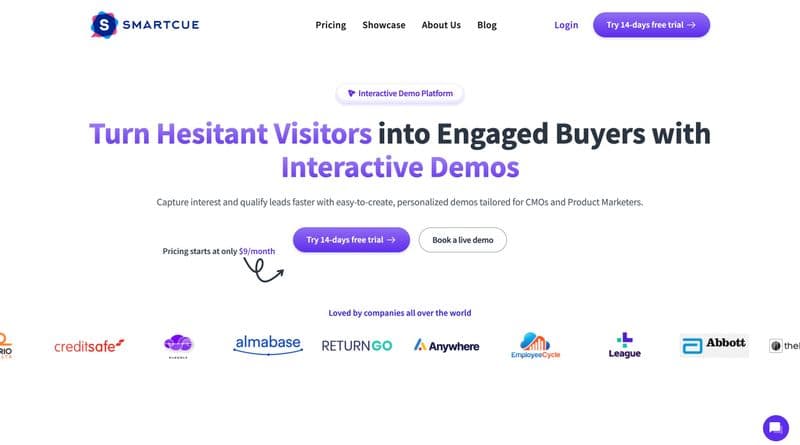
SmartCue is an intuitive, no-code demo creation platform built for sales, marketing, and customer success teams who want to create interactive, personalized product demos without technical support. Rated 4.8 by users on G2, it’s designed to help teams capture screens, add tooltips, and create guided walkthroughs in minutes.
Whether you’re showcasing a product to prospects, training new hires, or improving onboarding, SmartCue delivers an engaging, scalable demo experience with built-in analytics and enterprise-level security.
What Key Features Does SmartCue Offer?
No-code demo builder that lets you create interactive walkthroughs effortlessly.
AI-powered editing and personalization for customized demos across different audiences.
Real-time engagement analytics that track clicks, views, and completion rates.
Seamless CRM integrations, including HubSpot and Salesforce.
SOC 2 compliance with advanced access control and data protection.
Flexible use cases across sales demos, onboarding, customer education, and lead generation.
What Are the Pros and Cons of Using SmartCue?
Pros | Cons |
|---|---|
Simple, no-code demo creation anyone can use | Limited offline functionality |
Real-time engagement and usage insights | Some advanced analytics are still rolling out |
Fast setup with minimal learning curve | Minor UI refinements in progress |
Affordable, transparent pricing | - |
Responsive, feedback-driven product team | - |
Who Should Choose SmartCue?
SmartCue is ideal for startups, small businesses, and growing enterprise teams that need a fast, flexible way to build demos that convert. It’s perfect for anyone who wants to improve buyer engagement, streamline onboarding, or create product-led marketing content without paying for complex enterprise demo software.
How Much Does SmartCue Cost?
SmartCue offers flexible pricing plans designed to fit teams of all sizes:
14-Day Free Trial: $0
Essential Plan: $99/user/month (billed annually)
Growth Plan: $300/user/month (billed annually)
Enterprise Plan: Custom Pricing
What Do Customers Say About SmartCue?
"Smart Showcase Software"
"Simple to use platform for creating software demos. Once recorded, you can add a little intro card and call to action at the end of the demo. I appreciate the insights dashboard giving usage stats."
Mark D., Business Consultant – Marketing and Advertising (Small Business)
"Simple, easy to use and scales fast!"
“SmartCue is very intuitive and easy to use. It solves a real problem of creating demos quickly and without needing to record a perfect shot using video. I was able to create demos, how-tos, and product guides very quickly, as well as measure the audience’s engagement.”
Una J., CRO – Small Business, G2
Experience how effortless demo creation can be with SmartCue. Build, personalize, and share interactive product demos that engage and convert, without code or complexity.
Demostack vs Reprise vs SmartCue: How Do They Compare In Terms Of Features, Costs, and Limitations?
If you're already using a platform, the real question is: how do you know it's the right fit for your team? And, more importantly, when is it time to switch?
Let’s break down how to make the right call.
1. Demo Creation & Customization
Your demo should highlight your product’s value, not your team’s patience. A great platform makes building and updating demos fast, flexible, and frustration-free.
SmartCue: Wins here with its Chrome/browser extension that makes demo creation quick and frictionless. Teams can capture, edit, and launch demos in minutes, perfect for fast-moving startups and lean GTM teams.
Demostack: Uses front-end cloning for realistic environments but struggles with flexibility; workflow customization is limited, and updates must be done manually.
Reprise: Offers multiple demo types (live, click-through, leave-behinds) but requires technical setup for complex flows, slowing down non-technical teams.
2. User Experience & Interface
A demo tool should feel easy to use, not like another product to learn. Let’s see which platform keeps things simple for creators and viewers alike.
SmartCue: Exceptionally intuitive with a clean interface that anyone can pick up instantly. No training, no complexity, just plug in and build.
Demostack: The UI is clean and no-code friendly, but larger demos can lag, and deep edits often require workarounds.
Reprise: Has a guided structure and clear logic, but feels rigid when managing multiple demo versions or branching paths.
3. Scalability & Use Cases
As your product grows, your demo platform should grow with it. Scalability isn’t just about storage; it’s about managing different demos for different audiences efficiently.
SmartCue: Scales effortlessly across sales, onboarding, and marketing use cases without heavy setup or tool juggling. Teams can organize and deploy demos easily as they expand.
Demostack: Works well for mid-market needs but can become cumbersome when managing multiple, complex demo libraries.
Reprise: Enterprise-grade scalability but requires structured workflows and technical oversight, making it less agile for smaller teams.
4. Interactivity & Engagement
An effective demo doesn’t just show your product; it invites the audience to explore it. Interactivity plays a big role in engagement and conversion.
SmartCue: Allows prospects to explore naturally, just like in a live product. Teams can create tailored showcases and track where users click and linger.
Demostack: Supports basic interactivity but is best suited for linear, guided flows, less flexible for dynamic exploration.
Reprise: Enables interactive and guided experiences but can feel scripted, limiting free-form discovery for technical buyers.
5. Analytics & Insights
If you can’t measure engagement, you can’t improve it. The best platforms turn every demo interaction into actionable data.
SmartCue: Provides detailed engagement analytics that show what resonates most with viewers. Reports are clear, visual, and easy to act on.
Demostack: Offers engagement tracking but lacks depth; analytics stop at surface-level metrics.
Reprise: Delivers view and completion data but lacks granularity for multi-step interactions or real-time insights.
6. Automation & AI Capabilities
Automation can turn a time-consuming demo process into a repeatable, scalable workflow. The question is, which tool truly delivers smart automation?
SmartCue: Excels with practical AI and automation that streamlines demo personalization and reuse. It simplifies repetitive tasks without overcomplicating the setup.
Demostack: Offers some AI-powered personalization but still relies on manual demo upkeep.
Reprise: Includes template automation but lacks advanced AI recommendations or adaptive learning.
7. Integrations & Compatibility
Your demo platform should fit neatly into your tech stack, not force you to rebuild it. Smooth integrations are key to productivity.
SmartCue: Integrates seamlessly with HubSpot, Salesforce, and other CRMs. No workarounds or lag when embedding demos in sites or emails.
Demostack: Connects with CRMs but may require API customization for certain stacks.
Reprise: Integrates with major sales tools, though setup and embedding performance can be inconsistent.
8. Deployment & Implementation
Getting started should be fast, not a project in itself. Setup time and technical dependency can make or break a team’s adoption.
SmartCue: Plug-and-play simplicity, teams can go from signup to first demo in minutes, no IT involvement needed.
Demostack: Quick for basic setups, but deeper configurations often require developer input.
Reprise: Flexible but set up for advanced demos involves scripting and can be time-consuming for teams with limited resources.
9. Security & Compliance
Security is non-negotiable, especially for enterprise teams handling sensitive data. Compliance should come built-in, not bolted on.
SmartCue: SOC 2 compliant with granular access control, audit logs, and strong encryption, ideal for teams prioritizing data security.
Demostack: Offers standard encryption and role-based access but lacks deeper governance controls for large enterprises.
Reprise: SOC 2 certified with detailed permissions, but managing them at scale can be tedious.
10. Pricing & Value for Money
A demo platform shouldn’t drain your budget before it delivers results. Pricing should match value, not inflate it.
SmartCue: The clear winner on pricing, starting at just $99/year, offering full functionality without hidden fees. Flexible plans for startups and enterprises alike.
Demostack: Begins around $55,000/year, suited only for well-funded mid-market and enterprise teams.
Reprise: Starts at $38,000/year but often increases with add-ons, making it less predictable for budgeting.
Demostack vs Reprise vs SmartCue: Which One Will Actually Work for Your Team?
The wrong demo platform isn’t just an expensive mistake. It slows down your sales cycle, forces workarounds, and leaves your team stuck with rigid tools that don’t scale the way you need.
Maybe you want deep interactivity, but your platform locks you into static flows. Maybe you need scalable demo automation, but you're stuck manually updating every version.
Before you commit to a five-figure contract, let’s break it down: When does Demostack make sense? When is Reprise the better fit? And when should you skip both for something more flexible?
Go with Demostack If…
You need a quick, no-code clone of your product’s UI—without backend functionality.
You can work within a linear, click-through flow without deep interactivity.
You have the budget for a high-cost tool.
Go with Reprise If…
You want structured, guided demos with clear click paths.
You don’t mind some technical setup to get interactive elements working.
You’re okay with less flexibility in exchange for a more templated approach.
You can handle added costs for integrations and advanced analytics.
Go with SmartCue If…
You want to create interactive, shareable demos in minutes, no coding or cloning required.
You value flexibility and personalization, with the ability to tailor demos for different buyer personas or use cases.
You need scalable automation, with easy updates that don’t require re-recording or rebuilding entire flows.
You prefer transparent, affordable pricing that grows with your team, not a rigid, enterprise-only plan.
You want AI-powered insights and analytics to see how prospects engage with each demo and optimize conversions.
You’d rather spend time selling, not stitching together tools. SmartCue integrates smoothly with your existing CRM and sales stack.
Test It Yourself, 14 Days Free
How to Use SmartCue to Turn Interest into Action?
Let your product do the talking. Here’s how to create a standout demo in four simple steps!
Step 1: Sign Up & Install the Chrome Extension
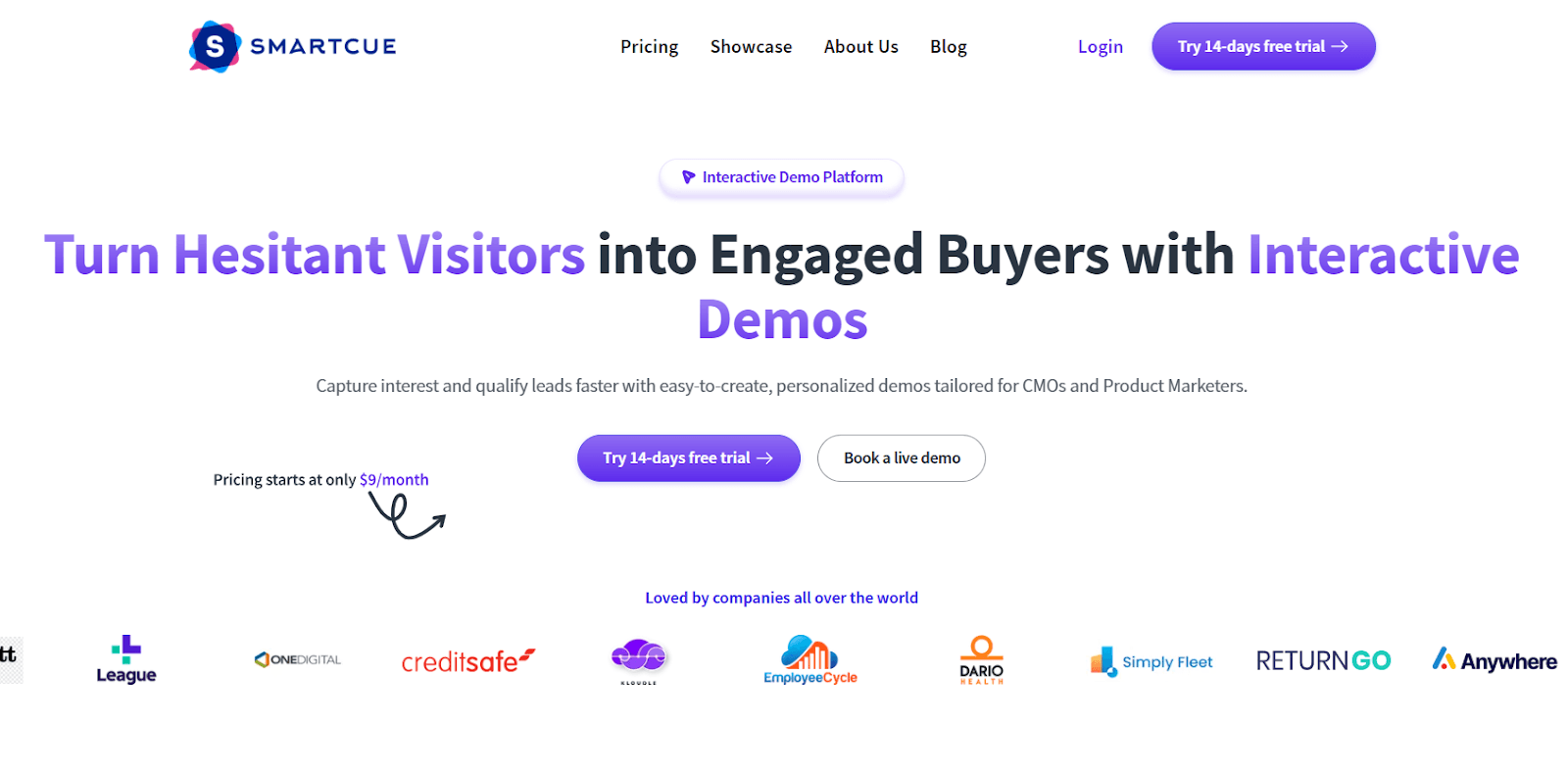
Start with a 14-days free trial and explore SmartCue’s intuitive interface.
Step 2: Capture & Build Your Demo
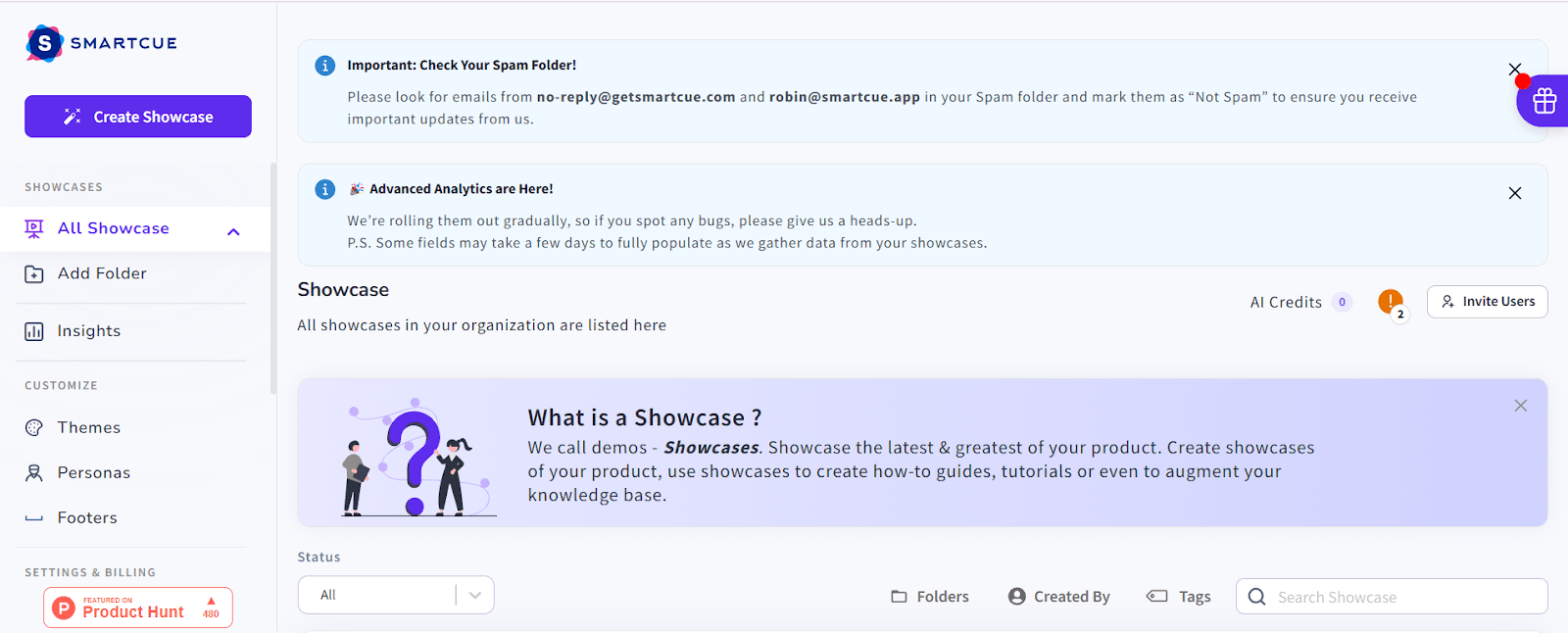
Use SmartCue to record your product walkthrough or start from a ready-made template.
Step 3: Customize for Clarity & Engagement

Add tooltips, text overlays, and interactive elements to guide prospects through your product’s value—without overwhelming them.
Step 4: Share & Track Engagement
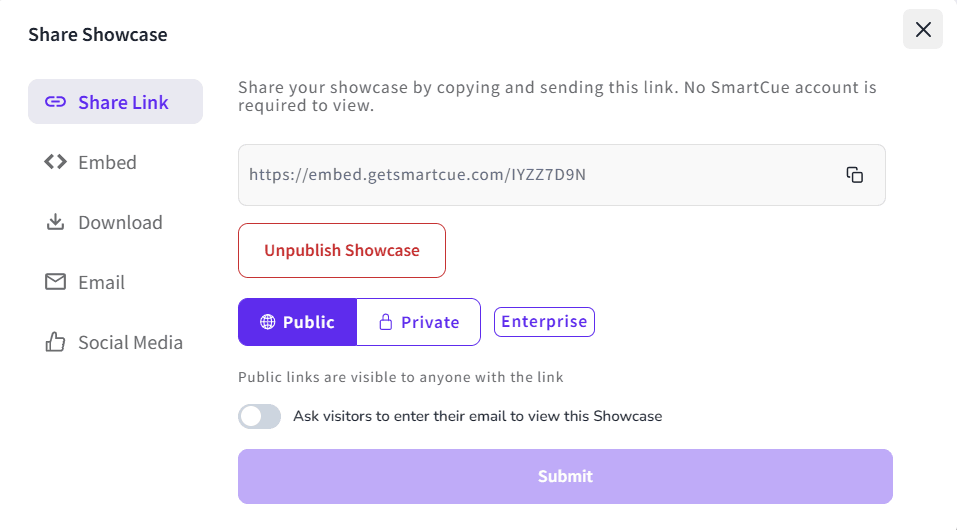
Send your demo link, then track which features prospects engage with the most, so you know exactly what resonates.
Who Can Benefit from SmartCue?
Sales Teams: Keep prospects engaged with demos they can explore on their own time, immersing them in a compelling product story with answers built in.
Marketing Teams: Embed interactive demos in campaigns and landing pages to generate high-intent leads.
Customer Success Teams: Reduce onboarding time with guided, step-by-step walkthroughs for new users.
Product Managers: Showcase new features and workflows effectively, without extra meetings or explanations.
Final Thoughts
A great demo isn’t just a prettier version of your product. It’s a sales tool. If your demo platform isn’t helping you close deals faster, shorten sales cycles, and make prospects say “wow”, then what’s the point?
This is where many teams get stuck. They invest in fancy platforms, thinking more customization or interactivity will solve their pain points. But complexity isn’t the answer; effectiveness is. If your team spends more time building demos than using them to sell, that’s a problem.
So ask yourself: Is your demo platform a strategic advantage or just another tool to manage? The right choice isn’t about having the most features; it’s about giving your sales team exactly what they need to win.
Frequently Asked Questions
What are the main differences between Demostack and Reprise for creating interactive product demos?
Demostack reviews focuses on a no-code approach to clone your product's front end, while Reprise reviews offers more flexibility with structured, guided demos. Both aim to improve the platform experience, but Demostack feels more like a demo hygiene tool that can be accessed directly from your laptop.
Which platform, Demostack or Reprise, offers more customization options for product demos?
Reprise offers deeper customization with dynamic elements like live dashboards, while Demostack has limited customization and just demo hygiene. Reprise also supports fresh data and graphs for more impactful, interactive walkthroughs.
How do Demostack and Reprise compare in terms of pricing and subscription plans?
Demostack’s pricing starts higher, while Reprise offers more affordable plans with some hidden add-ons. Both platforms can offer a consistent experience, but Reprise’s flexibility may provide better business outcomes for a wider range of budgets.
What are the pros and cons of using Demostack versus Reprise for SaaS product demonstrations?
Demostack offers faster demo build time, but lacks deeper customization and can feel like a mobile app demo. Reprise, on the other hand, gives more interactive options, but may have a steeper learning curve.
Which tool, Demostack or Reprise, is easier to integrate with existing CRM and sales platforms?
Both platforms integrate with CRMs, but Demostack’s setup is simpler for presales teams, offering a consistent experience. Reprise has a much stronger story for large enterprise solutions and can be more complicated for integration.
How do customer reviews for Demostack and Reprise compare on platforms like G2 or Gartner?
Customer reviews show that Demostack excels in quick demos and easy-to-use platforms but lacks advanced features. Reprise is often praised for being a total game-changer in customization, but users report that it requires more time and expertise.
Does Demostack provide any unique features not available in Reprise, or vice versa?
Demostack allows users to quickly create demo assets with a focus on live app Demostack demos, while Reprise offers deeper customizations, such as solution consultants creating different versions of the demo environment for complex use cases.
Are there any major companies or industries that prefer Demostack over Reprise, or the other way around?
Gainsight’s sales team prefers Demostack for quick, less complex demos, while companies with more robust needs, like partner users, and AEs, tend to choose Reprise for its flexible platform experience and ability to showcase the actual platform in the first place.
What kind of customer support and onboarding services do Demostack and Reprise offer?
Demostack provides expert guidance for quick setup, while Reprise offers more detailed training, ensuring users understand how to handle complex demo builds and showcase the value of our product. This empowers account executives with the tools they need at their disposal to easily adapt to the platform.
Is there a free trial or demo available for both Demostack and Reprise, and how do they compare?
Both platforms offer demos, but Demostack’s demo hygiene approach is quicker to implement, while Reprise provides a more tailored demo with a deeper feel of our actual products, making it a stronger choice for in-depth demos.


